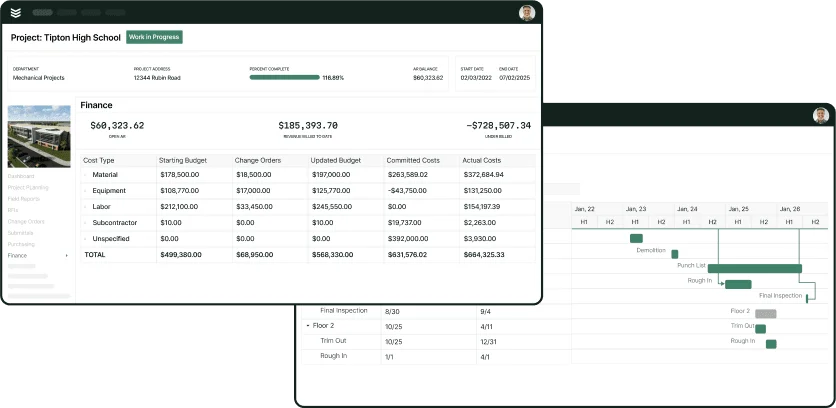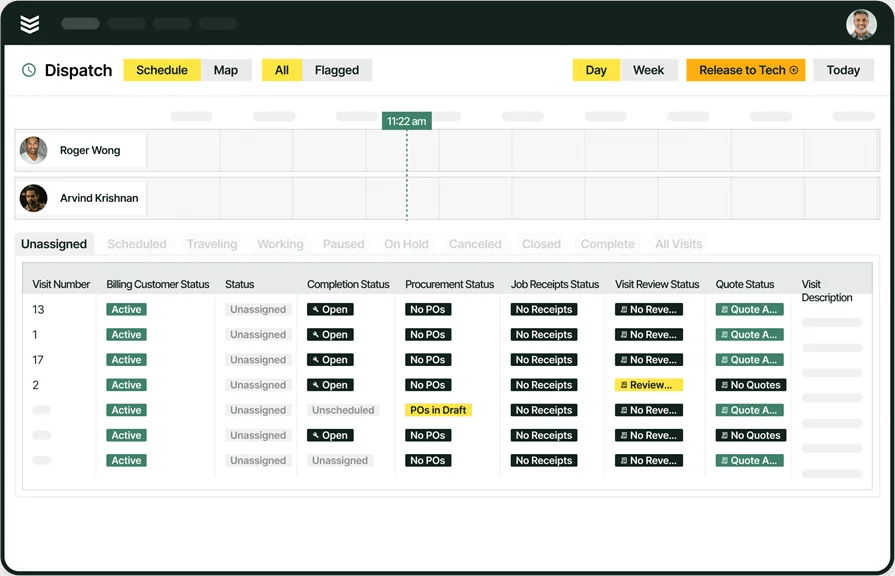Juggling multiple crews, subcontract agreements, and shifting jobsite demands isn’t for the faint of heart. If you’re a construction subcontractor, you already know how quickly a project can go sideways when communication breaks down or paperwork piles up. That’s where construction subcontractor project management software steps in. It helps you tighten timelines, track labor and costs, and stay aligned with general contractors—without relying on spreadsheets and whiteboards.
The right platform gives subcontractors a better grip on scope, schedules, and submittals across every phase of the build. Whether you’re managing structural steel, framing, or finish trades, today’s tools make it easier to keep crews in sync and work on track. This guide breaks down how to choose the right system, which features matter most, and how to stay competitive in a chaotic market. For subcontractors exploring their options, it's worth considering how construction field service management platforms fit into the mix—especially if you're balancing both project and service work. Here’s what we’ll cover:
- Choosing a construction subcontractor project management software for your business
- 6 key features to look for in construction project management software for subcontractors
- Best for commercial subcontractors
- Best for residential subcontractors
- Best for subcontractors working under general contractors
- Other helpful construction project management tools worth considering for subcontractors
- 7 benefits of construction project management software for subcontractors
- 4 important FAQs about using construction project management tools
Before diving into software features, it’s worth stepping back and asking: what problems are you actually trying to fix? If your punch lists never end, your team spends half their time chasing updates, or your change orders keep falling through the cracks, then a new system might be the shift your business needs.
Choosing a construction subcontractor project management software for your business
Subcontractors don’t control the whole project—but they carry the weight when deadlines slip, RFIs lag, or materials don’t show. Unlike GCs, subcontractors are locked into tighter scopes, fixed timelines, and stricter coordination windows. That’s what makes construction subcontractor project management software different. You’re not looking for some one-size-fits-all tool. You need a system that works in the real-world chaos of sub work—where job changes come mid-install, coordination happens across trades, and your crew still has to deliver clean, tight work.
Estimating, scheduling, and tracking aren’t side tasks—they’re your edge. Whether you’re pouring concrete or hanging drywall, having construction project management software for subcontractors gives you the visibility and control to stay ahead of issues, not buried by them. Here’s what to think through before choosing a platform:
- Scope and project type - Are you managing long-term structural jobs or fast-turn specialty trades? Does your team switch between commercial TI work and residential remodels? Are you constantly adjusting scope after GC walk-throughs? Your software needs to flex around how your jobs actually unfold, not just list tasks on a timeline.
- Coordination and field updates - How fast can your field leads share status updates, change orders, or RFIs? Is everything stuck in texts and PDFs—or tracked in a single system your office can see? Are delays and handoffs clearly documented and tied to actual job progress?
- Crew scheduling and labor allocation - Are your crews moving efficiently between sites? Can you shift manpower when one trade falls behind or an inspection stalls progress? Do your PMs have a real-time view of labor availability, task progress, and equipment usage?
- Billing, documentation, and compliance - Are change orders tied directly to your cost tracking? Can you back up your invoices with logged hours and field notes? Is your team still chasing down timecards and photos to get paid? You need project records built into your workflow—not bolted on after the fact.
- Features - Does the system support daily logs, RFIs, submittals, change orders, and punch list management natively? Can you integrate it with tools you already use for accounting or estimating? Will your field and office teams actually use it—or does it sit idle because it's too clunky?
Before choosing construction subcontractor project management software, focus on how your jobs actually operate. Generic tools won’t cut it when you're juggling shifting schedules and mid-project changes. Up next—key features that matter for subcontractors and where the best construction project management software for subcontractors stands out.
6 key features to look for in construction project management software for subcontractors
When you’re a subcontractor, staying ahead of the chaos isn’t optional—it’s survival. You're not just tracking your crew. You're coordinating with GCs, reacting to RFIs, juggling trades, and documenting every inch of work to get paid. Construction subcontractor project management software needs to support that reality: fast-moving jobs, shifting priorities, and lean field crews who don’t have time to dig through spreadsheets or wait on callbacks from the office.
These features aren’t about checking boxes—they’re about staying productive, protected, and profitable on every job.
1. Field scheduling and labor coordination
Construction schedules are always moving. Whether you're waiting on concrete to cure or the framer is behind, your ability to adjust your team’s tasks on the fly is critical. A strong field service scheduling tool helps you assign the right crew to the right job, keep everyone updated, and avoid costly downtime.
Let’s say your plumbing crew was scheduled for a slab rough-in Tuesday, but the foundation pour got delayed. With dynamic scheduling built into your construction subcontractor project management software, you can instantly reassign them to a prep job across town, alert the crew via mobile, and adjust resource allocations without the paper shuffle. That kind of visibility keeps your labor productive—not standing around waiting.
2. Dispatch management
Subcontractor dispatch isn’t just about sending people to a site—it’s about managing permits, jobsite readiness, crew sequencing, and access. Construction field service dispatch software lets you track truck locations, field team status, and job progress all in real-time.
Here’s a scenario: A sheet metal crew finishes early at one job, and another site is falling behind on duct install. Instead of waiting for a foreman to call it in, your dispatcher reroutes the nearest crew directly to the second job, updates the schedule, and alerts the GC—all through the system. That’s how construction project management software for subcontractors saves hours and closes gaps before they turn into delays.
3. Technician mobile access
Your field team shouldn't have to walk to the trailer to check a drawing or log time. They need everything—from scope changes to job notes—right on their phone. With mobile access tools, techs can upload photos, mark up plans, log time, and complete checklists from the field. Take, for instance, a finish carpenter who runs into an unexpected conflict with an MEP rough-in. Instead of halting work or guessing, they snap a photo, flag the issue in-app, and send it straight to the PM. No delays, no confusion. That speed is what sets the best construction project management software for subcontractors apart from general tools.
4. Invoicing and payment processing
Delayed invoices kill cash flow—and subcontractors can’t afford to wait. Construction field service invoicing and payment processing tools that tie directly to job data make it easier to bill immediately when work wraps. Let’s say your tile crew wraps up a hotel bathroom install ahead of schedule. With integrated billing, the foreman logs completion in the field, triggering an invoice that the office reviews and sends that afternoon. The GC gets it fast, you get paid faster. No chasing down signatures or digging through job folders.
5. Reporting and job costing
You can’t manage what you can’t see. Real-time reporting and job costing tools give subcontractors insight into labor hours, material costs, delays, and job profitability—without spreadsheets or guesswork. Say your structural crew just finished a mid-rise pour, and you want to know how labor trended compared to budget. You pull the report and see they ran over two days on one phase, but beat schedule on another. That level of insight helps you adjust bids, crew sizes, and timelines with hard data—not gut feelings.
6. CRM for subcontractors
Subcontractors rely heavily on repeat business from GCs and developers. Having a solid CRM for construction helps you track every interaction, job history, site preferences, and quote follow-ups—so you never miss an opportunity. Picture this: A GC you worked with two years ago calls out of the blue asking for a quote. You pull up their past job details, including specs, crew notes, and photos. Instead of starting from scratch, you already have everything you need to win the next job. That’s relationship management that actually works for subcontractors.

Explore our project management suite
See how we help teams effectively manage jobs from first quote to completion.
Other valuable features to watch for in subcontractor project management software
While core scheduling, dispatch, and reporting features do the heavy lifting, there are additional tools that can make day-to-day operations far smoother for subcontractors. The demands placed on construction subs—tight coordination windows, layered approvals, limited control over jobsite pace—mean every added layer of automation and visibility counts. These extra capabilities don’t just add convenience—they help crews stay productive, reduce overhead, and tighten project timelines.
- Time tracking integration - Subcontractors often work on multiple jobs in a single day, making precise labor tracking a challenge. A time tracking solution integrated with your construction subcontractor project management software lets crews log hours by job, task, or cost code, reducing payroll errors and improving job costing accuracy. PMs can monitor field hours in real-time, giving them better control over productivity and labor allocation.
- Fleet and equipment tracking - When tools and vehicles are constantly in motion between job sites, fleet tracking software becomes critical. Subcontractors can monitor vehicle usage, reduce fuel waste, schedule maintenance, and ensure assets are where they’re needed. This level of visibility helps prevent delays caused by missing or unavailable equipment and supports better logistics planning.
- Service agreement management - For subcontractors handling service or maintenance contracts in addition to project-based work, service agreement tools can bring everything under one roof. Track renewals, ensure compliance with contract terms, and schedule recurring work without manually managing spreadsheets or calendars. This helps subcontractors stay organized while unlocking steady revenue alongside project income.
Next, we’ll dig into the tools that stand out depending on the type of subcontractor work you handle—commercial, residential, or working under a general contractor.
Best for commercial subcontractors: BuildOps
BuildOps is designed for commercial subcontractors managing tight deadlines, multi-trade schedules, and complex coordination. It combines dispatching, field updates, job costing, and billing into one system that is built for fast-paced construction projects where missing a beat can cost you the job.
How pricing works: Custom pricing based on team size, features, and workflow complexity.
Features beyond project management: Includes mobile access, technician tracking, labor and cost reporting, invoicing, and time tracking—all tied to live job data.
What sets it apart for commercial subcontractors: Every feature is tuned to the daily pressure of sub work on large projects—giving you the control to keep jobs moving, subs accountable, and margins protected.

Want to see BuildOps in action?
We bring office and field tech together—so nothing slips through the cracks.
Best for residential subcontractors: Fieldwire
Image Source: Fieldwire
Fieldwire is a lightweight mobile app built for residential subs who need a simple way to assign tasks, manage punch lists, and track field updates. Its clean interface makes it easy for smaller crews to get up and running quickly—but it lacks the deeper job costing and billing capabilities that larger subcontractors often require.
How pricing works: Free plan available, with paid tiers starting around $39 per user per month.
Features beyond project management: Supports plan viewing, checklist creation, photo capture, and basic task scheduling.
What sets it apart for residential subcontractors: Easy to use and fast to deploy for teams focused on short-cycle residential work, but limited if you need broader project oversight or financial tracking.
Best for subcontractors working under general contractors: Procore
Image Source: Procore
Procore offers a deep platform for subs who need to tightly align with GCs on major commercial builds. It handles everything from submittals to RFIs and change orders—ideal for trades working on complex, multi-phase jobs. That said, the system’s size and learning curve can be a hurdle for smaller subcontractors or those who don’t need enterprise-level tools.
How pricing works: Quote-based pricing that scales with user count and project complexity.
Features beyond project management: Document management, field collaboration, drawing annotations, and detailed cost control tools.
What sets it apart for subcontractors under GCs: Built for teams that need to plug into a GC’s workflow without dropping the ball on approvals, coordination, or documentation.
Other helpful construction project management tools worth considering for subcontractors
Depending on your trade, crew size, and workflow, a more specialized or lightweight construction subcontractor project management software might be the better fit. Whether you're focused on daily reports, internal communication, or financial visibility, the following tools offer niche solutions that may complement or replace broader platforms—especially if your operation is still growing or tightly focused.
While some subcontractors need a full-scale platform, others might benefit from leaner, more targeted construction subcontractor project management software. These tools can help bridge specific gaps like documentation, financial tracking, or GC communication—especially for teams looking to boost efficiency without committing to complex systems. Each one brings something unique to the table, but also comes with trade-offs depending on your operation size, trade type, and workflow needs.
Raken
Image Source: Raken
Raken is designed for subcontractors who need simple, fast field reporting and documentation. It streamlines daily logs, time cards, safety tracking, and production reporting. However, it doesn't offer full scheduling, dispatch, or invoicing capabilities—making it better as a companion tool rather than a full project management system.
How pricing works: Starts at $15/month per user for core features, with add-ons available for larger teams.
Features beyond project management: Includes digital toolbox talks, photo documentation, time tracking, and compliance logs.
What sets it apart for subcontractors: Great for documentation-heavy trades that need clean, trackable daily reporting but not full-scale coordination tools.
Contractor Foreman
Image Source: ContractorForeman
Contractor Foreman is an all-in-one platform focused on affordability for small to midsize subcontractors. It covers everything from estimating and scheduling to safety reports and invoicing. While powerful for its price, it can feel clunky in layout and lacks the polish of more premium solutions, which can slow adoption.
How pricing works: Tiered pricing starts at $49/month with no per-user fees, making it budget-friendly for smaller crews.
Features beyond project management: Offers incident tracking, bid management, Gantt chart scheduling, and client portals.
What sets it apart for subcontractors: It delivers broad functionality at a low price point, making it ideal for budget-conscious shops needing a little bit of everything.
Buildertrend
Image Source: Buildertrend
Buildertrend’s subcontractor software excels at linking subcontractors to general contractors through shared communication tools. It enables GCs to assign tasks, share schedules, and track punch lists in a centralized platform. That said, it’s mainly GC-focused, so subs using it as their primary system may find it limiting in field-specific workflows and internal coordination.
How pricing works: Subscription-based, typically bundled with GC accounts. Subcontractor access is usually included by the GC.
Features beyond project management: Includes messaging, file sharing, change order approvals, and subcontractor progress tracking.
What sets it apart for subcontractors: Best for subs working directly within a GC’s Buildertrend environment and needing a seamless collaboration path—but not a full internal ops platform.
Buildern
Image Source: Buildern
Buildern offers a modern interface with tools for budgeting, cost tracking, scheduling, and client communication. It’s user-friendly and visually clean, which appeals to smaller subcontractors. However, its toolset is still growing, and it lacks deeper integrations and field-specific dispatch features needed by larger or more mobile crews.
How pricing works: Offers tiered pricing starting at $99/month for small teams, with enterprise plans available.
Features beyond project management: Includes proposal generation, project budgeting, invoice tracking, and simple client portals.
What sets it apart for subcontractors: Ideal for smaller subs who want simplicity and transparency in project finances but don’t need complex field coordination.
Knowify
Image Source: Knowify
Knowify’s subcontractor management software brings financial clarity to subs managing multiple small-to-mid-size jobs. It excels at job costing, billing, and contract compliance—but doesn’t provide the robust field service dispatch or labor scheduling larger subcontractors often require.
How pricing works: Plans start at $149/month and scale with users and features.
Features beyond project management: Offers estimate templates, contract tools, invoice generation, and job profitability tracking.
What sets it apart for subcontractors: It shines for teams who need to closely manage financials across several jobs but don’t rely heavily on daily dispatching or mobile tasking.

Compare software at a glance
See how tools stack up with this easy to use software scoresheet.
7 benefits of construction project management software for subcontractors
Construction subcontractors face a different kind of pressure. You’re not just managing work—you’re managing around others. You’re juggling schedules you don’t fully control, hitting tight deadlines, and proving your value on every job. That’s where construction subcontractor project management software earns its keep. These aren’t just tools—they’re built-in advantages that help you move faster, stay aligned, and get paid with fewer headaches.
1. Faster scheduling adjustments
When another trade runs late or an inspection stalls the timeline, you need to reassign crews without the chaos. With construction subcontractor project management software, real-time visibility into labor and job status means you can pivot instantly and keep your crew billable. Tools built for subcontractor scheduling reduce downtime and give you control over your labor—even when the master schedule shifts.
2. More accurate job costing
Subcontractors live and die by job costing. Having access to detailed labor, material, and production data in real time helps you protect margins before they vanish. Construction project management software for subcontractors tracks actuals as they happen, giving you the insight to course-correct mid-project—not after the damage is done. It's a key reason more teams are adopting platforms designed for commercial construction project management.
3. Improved field-to-office alignment
Miscommunication between your field crew and the back office creates delays, errors, and rework. With everything centralized in one system—from daily logs to change orders—your PMs don’t have to chase updates or decode text threads. That alignment is exactly what construction field service management tools are designed to solve—keeping everyone on the same page without constant check-ins.
4. Faster billing and payment turnaround
When job data flows straight into billing, your team isn’t stuck chasing timecards or paperwork to send invoices. That means faster payment cycles and fewer billing disputes. Subcontractor project management software with integrated invoicing closes the gap between job completion and cash in hand—one of the most overlooked advantages in contractor project management workflows.
5. Less rework and fewer jobsite mistakes
When task updates, approvals, and changes are tracked in real time, your crew knows exactly what’s been done—and what’s still pending. That reduces double work and keeps your jobs clean and compliant. Subcontractors benefit from having a digital audit trail tied directly to each task or trade sequence.
6. Stronger documentation and accountability
From RFIs and submittals to crew hours and photos, everything is logged automatically. That means you can back up your work with facts, not emails. It also protects you in disputes and change order negotiations—critical for subs constantly coordinating with external teams.
7. Greater professionalism in GC relationships
Showing up with solid documentation, clear timelines, and organized records builds trust with general contractors. It shows you’re not just delivering labor—you’re delivering results. The best construction project management software for subcontractors gives you a professional edge that sets your team apart on bid day and build day.
4 important FAQs about using construction project management tools
Subcontractors are under constant pressure to stay organized, hit deadlines, and manage multiple moving pieces—all while responding to the demands of GCs and shifting jobsite conditions. Here are the most common questions subcontractors ask about using construction project management software, and what you need to know before investing.
1. What is construction project management software for subcontractors?
Construction project management software for subcontractors helps manage their part of the job—from planning and scheduling to documentation and billing—without getting buried in paperwork or losing time to miscommunication. It’s designed to keep crews aligned and jobs moving without delays.
Unlike GC software, it’s tailored to the unique workflow of subs: juggling crews across jobs, tracking change orders, and staying aligned with general contractors while keeping internal operations tight. It centralizes everything you need to manage labor, tasks, approvals, and job costs in one connected platform.
2. How does project management software work for construction subcontractors?
It connects your field crew, project managers, and office team through one system that updates in real time—so everyone sees the same info, no matter where they are. Here's what it usually handles:
- Assigns and updates crew schedules based on real-time job progress
- Sends dispatch instructions and task details directly to field techs
- Tracks materials, labor hours, and equipment usage against budgets
- Logs and organizes change orders, RFIs, and approvals for fast reference
- Automates daily reports and safety documentation from the field
- Syncs updates to billing, payroll, and job costing without manual entry
With a good system in place, subcontractors can move faster, make fewer mistakes, and stay ahead of project delays.
3. Is construction project management software worth the cost for subcontractors?
For subcontractors dealing with multiple jobs, shifting crews, and tight margins—the answer is yes. It reduces costly mistakes, shortens billing cycles, and helps crews stay productive without chasing down updates or paperwork. The return comes not just in time saved but in tighter control over labor, faster documentation, and fewer issues slipping through the cracks. When used right, it more than pays for itself in avoided delays and reclaimed hours.
4. What are some best practices to follow when implementing project management software as a construction subcontractor?
Rolling out construction project management software is more than plugging in a new system—it’s about getting buy-in and aligning the software with how your jobs actually work. Start small, train your crew, and build momentum from real wins. Here are 10 best practices construction subcontractors can follow:
- Identify real problems to solve—like delayed billing or missed updates
- Involve field leads early—they know what slows jobs down
- Use subcontractor-focused software, not generic platforms
- Start with one division or crew before scaling company-wide
- Train field techs on how to log time, notes, and photos from their phones
- Set up templates for repeat jobs—framing, install, finish, etc.
- Integrate with billing and payroll to eliminate double entry
- Track how often teams actually use the system
- Ask your crew for feedback—then adjust
- Keep refining workflows to match how your business grows
The goal isn’t just adoption—it’s making sure your team sees the value and uses it to work smarter, not harder.
Being a subcontractor means walking the line—between your scope and the GC’s schedule, between productivity and paperwork, between keeping crews moving and staying profitable. That’s why generic tools don’t cut it. You need construction subcontractor project management software that’s built for the jobsite chaos you live in, not some one-size-fits-all solution designed for GCs or developers.
Whether you’re managing drywall across three floors or handling electrical trim-outs on a tight timeline, the right platform brings clarity to your workflow and accountability to your team. It ties together scheduling, documentation, billing, and updates so your crew isn’t stuck waiting, guessing, or redoing work. And for subcontractors working in commercial field service, platforms like BuildOps help bring that full picture together—from quote to closeout—all in one place.

Streamline project management
See how you can supercharge operations and keep cash flow moving.







